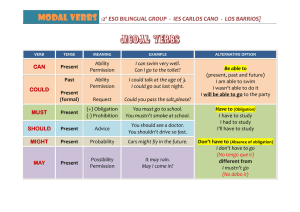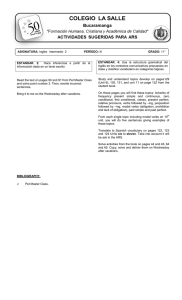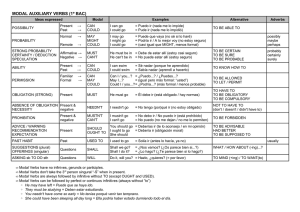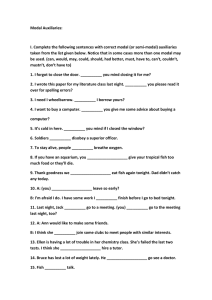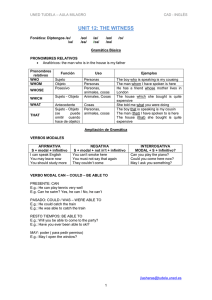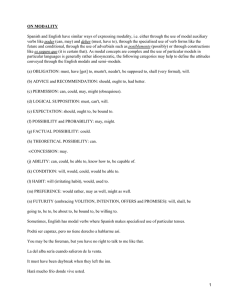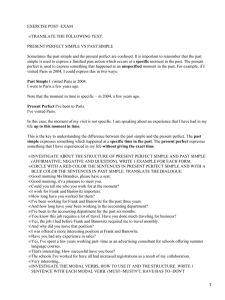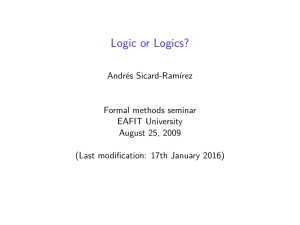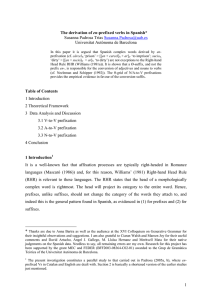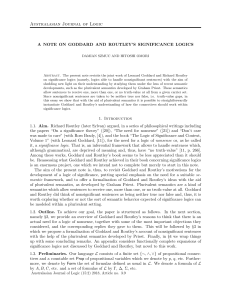Approximations of Modal Logics: K and Beyond - IME-USP
Anuncio
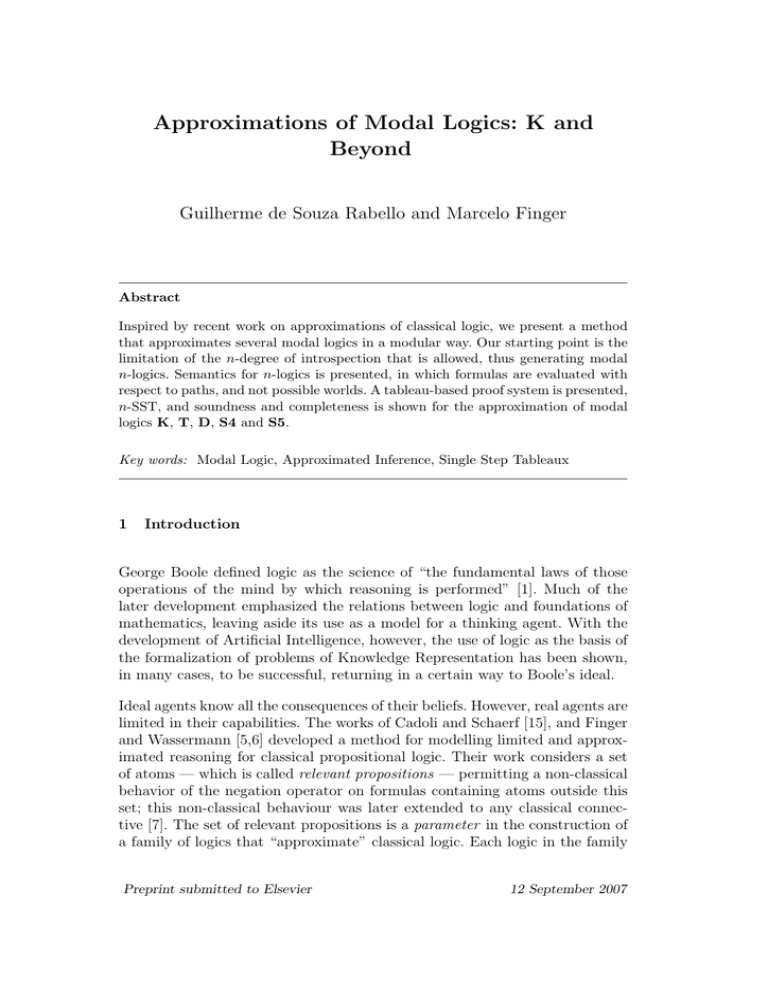
Approximations of Modal Logics: K and
Beyond
Guilherme de Souza Rabello and Marcelo Finger
Abstract
Inspired by recent work on approximations of classical logic, we present a method
that approximates several modal logics in a modular way. Our starting point is the
limitation of the n-degree of introspection that is allowed, thus generating modal
n-logics. Semantics for n-logics is presented, in which formulas are evaluated with
respect to paths, and not possible worlds. A tableau-based proof system is presented,
n-SST, and soundness and completeness is shown for the approximation of modal
logics K, T, D, S4 and S5.
Key words: Modal Logic, Approximated Inference, Single Step Tableaux
1
Introduction
George Boole defined logic as the science of “the fundamental laws of those
operations of the mind by which reasoning is performed” [1]. Much of the
later development emphasized the relations between logic and foundations of
mathematics, leaving aside its use as a model for a thinking agent. With the
development of Artificial Intelligence, however, the use of logic as the basis of
the formalization of problems of Knowledge Representation has been shown,
in many cases, to be successful, returning in a certain way to Boole’s ideal.
Ideal agents know all the consequences of their beliefs. However, real agents are
limited in their capabilities. The works of Cadoli and Schaerf [15], and Finger
and Wassermann [5,6] developed a method for modelling limited and approximated reasoning for classical propositional logic. Their work considers a set
of atoms — which is called relevant propositions — permitting a non-classical
behavior of the negation operator on formulas containing atoms outside this
set; this non-classical behaviour was later extended to any classical connective [7]. The set of relevant propositions is a parameter in the construction of
a family of logics that “approximate” classical logic. Each logic in the family
Preprint submitted to Elsevier
12 September 2007
proves a subset of classical theorems, which increases monotonically with the
set of relevant propositions; the approximation process consists of extending
the parameter set when a certain approximated logic cannot prove a specific
theorem, moving to a more powerful logic. This approximation process can
be transformed into an anytime algorithm for theorem proving, as noted by
Massacci [13].
In this paper, we concentrate on studying the approximation process for modal
logics. There are at least two sources of complexity in modal logics: logical omniscience and unbounded logical introspection 1 . Logical omniscience means
that the thinking agent knows all the consequences of his beliefs. The work of
Finger and Wassermann, among others, give a method to control this feature
in classical logic, and this method is easily translated to modal logic. This
paper is concerned with the other source of complexity. Unbounded logical introspection allows an agent to reason about his beliefs of his beliefs . . . of his
beliefs. Limitation is accomplished by selecting a maximum limit of introspection, inside which the agent can reason classically about its beliefs; outside,
the behavior is non-normal. By selecting arbitrarily large limits of introspection, we can recover classical normal modal logic. In this case, the parameter
of approximation is this number, the maximum limit of introspection. It is
this kind of limitation that we study in this paper.
In fact, we define a modal logic of limited introspection, called n-logic, where
n is the maximum limit of introspection. The logic is defined semantically
and, unlike usual presentations of modal logics, the semantics is evaluated
with respect to a path in a frame (W, R), not a single possible world. As is
usual in modal logics, by imposing several properties to the class of frames
we obtain several approximated modal n-logics, such as K, T, D, S4 and S5.
Semantically, we define a relation |=nL , where L ∈ {K, T, D, S4, S5}. The idea
of approximation is expressed by the fact that:
|=0L ⊆ |=1L ⊆ . . . ⊆ |=nL ⊆ |=n+1
⊆ ...
L
As the number of introspection steps is finite for every formula, for every
classically L-valid ψ, |=L ψ, there exists an n such that ψ is n-valid, |=nL ψ.
On the proof theoretical side, we present a tableau-based proof theory in the
context of Massacci’s Single Step Tableaux (SST), giving rise to an approximation proof system which we call n-SST, represented by ⊢nL . Due to the
evaluation of formulas over paths, not on worlds, the proof theory has to be
adapted, so n-SST’s rules contain some fundamental modifications over those
of of SST. Soundness and completeness of this approach is then shown for
1
We observe that the use of the word “introspection” is usually restricted to the
context of epistemic logic. Following [13], we extend its use to any modal logic.
2
several logics, ie, we show that |=nL ψ iff ⊢nL ψ.
Related Works
This work extends and modifies considerably the work presented in [3]. That
work dealt basically with n-approximations of modal logic K. Here, by extending the approach to several other logics, we had to modify both the semantics
and the proof theory. In fact, here formulas are evaluated with respect to
paths, while in [3] they were evaluated with respect to possible worlds. The
n-SST proof theory is also accordingly recast, so that the proof system presented has a more uniform and modular conception, and incorporates more
fundamentally the idea of limiting the degree of introspection.
The current paradigm of approximating logics was proposed by Cadoli and
Schaerf [15] in the context of clausal propositional logic. Annette ten Teije et
al. [17] pioneered modal approximation, although they do not define a proof
theory. Massacci [13] made the first complete attempt to extend Cadoli and
Schaerf’s approach to modal logics, inheriting both the good qualities of that
approach, as well as some shortcomings. As a result, Massacci’s approximation
does not deal with pure formulas, but only with signed formulas, revealing a
bias for dealing with tableau proof systems. A different approach to approximation was proposed by Finger and Wassermann [5,6], in which pure propositional formulas could be dealt with, and several approximated proof methods
were studied, including tableaux. In [7] it is shown that Cadoli and Schaerf’s
approach is based on giving a non classical treatment to the negation connective, but there it is shown that an approximation can also be based in any
other connective. In fact, in [4] it has been shown that approximation needs
not be based on any connectives, and can be performed by limiting the use of
the cut inference rule.
In comparison, the approach here is totally orthogonal to how the propositional approximation is done, and even if any such approximation is done
at all. Unlike Massacci’s modal approximation, that appears to be based on
pragmatic considerations, our modal approximation is based on limiting the
allowed degree of introspection, and we deal with pure formulas. In the context of Hilbert-style derivation systems, this kind of approximations is known
in the work of Ghilardi [10]. The approach here can be later combined to any
other propositional forms of approximation.
The rest of the paper develops as follows. Section 2 presents the notations
used, some concepts of modal logics necessary for the following sections and
what do labeled signed formulas (used in the tableau-based proof theory)
mean. Section 3 presents the semantics of the approximating logics, examples
3
and a theorem that states exactly what is needed to determine the truth of
a formula in an approximating logic. Section 4 presents a modular tableaubased proof theory for several modal logics in the context of n-SST; it presents
several examples and proofs of soundness and completeness of the tableaux
rules with respect to the semantics of Section 3. In the conclusion, possible
directions for future research are discussed.
2
Preliminaries
We assume familiarity with the basics of modal logics as presented, for instance, in [11], and Smullyan’s tableaux [16]. Notations are as follows. The
language is based on a denumerable set A of propositional variables, or atoms,
and contains the logical symbols ¬, ∧, ∨, ⊃, and ♦. Atoms will be denoted
by lower case latin letters in italics (as in p, q and r). Formulas will be denoted
by lower case Greek letters (as in φ and ψ).
Consider a model M = hW, R, vi for a modal logic. In this model, W is a
set of possible worlds, R ⊆ W × W is the accessibility relation and v : W →
(A → {0, 1}) is a function that assigns to each world w ∈ W a propositional
valuation. Different modal logics have different restrictions on the accessibility
relation. For instance, in logic T it is reflexive (∀w wRw); in logic D it is serial
(∀w∃w′ wRw′ ); in logic K4 it is transitive (∀ww′ w′′ (wRw′ ∧w′ Rw′′ ⇒ wRw′′ )).
In the logic K there are no restrictions on R.
The modal depth in a formula φ, N (φ), is defined as follows: if p is an
atom, N (p) = 0; N (¬φ) = N (φ); N (φ ∧ ψ) = N (φ ∨ ψ) = N (φ ⊃ ψ) =
max{N (φ), N (ψ)}; N (φ) = N (♦φ) = N (φ)+1. As an example, N (♦¬(p∧
♦q)) = 3.
We shall define truth with respect to paths over (W, R), and not worlds, which
for technical reasons are better suited here. There follows the definitions and
notations used.
Definition 2.1 A path ρ from w1 to wm is a sequence w1 Rw2 , . . . , wm−1 Rwm
and can be denoted ρ = w1 Rw2 R · · · Rwm−1 Rwm . The elements w1 and wm of
the path ρ are denoted by A(ρ) and Ω(ρ), respectively. If m = 0, the path is
empty (has no elements).
Definition 2.2 The size of the path ρ = w1 Rw2 R · · · Rwm−1 Rwm , denoted by
|ρ|, is m − 1. Empty paths have size −1. A minimal path from world w to
world t is a path with the shortest size.
A world w ∈ W can be identified with a path of size 0. Suppose that wRw1 .
4
We can designate the path wRw1 Rw2 R · · · Rwn by wRρ. The meaning of ρRt,
wRρRt and similar expressions is defined analogously. Observe that, when ρ
is empty, the world w can be identified with the size 0 path w = ρRw = wRρ.
Definition 2.3 An immediate successor of a path ρ is any path ρRt. The set
of ρ’s immediate successors is denoted by S(ρ).
Our intuition is that a path is associated with the degree of introspection
needed to arrive at the truth of a modal formula. So, if we are worried about
the truth of a formula an n-sized path, it means that we needed to make n − 1
introspection steps to reason about another formula in the first world of the
path. The use of paths is needed to make our approach work, avoiding the
need to constantly worry about the number of introspection steps.
In Section 4, we use a variant of Massacci’s Single Step Tableaux (SST) [14].
SST is itself a variant of Fitting’s prefixed tableaux [8,9]. Tables 1 and 2 show
the unifying notation in the presentation of signed tableau rules. Signed formulas are expressions T φ and F φ for a formula φ. Intuitively, T φ means “φ is
true” and F φ means “φ is false”; so T φ has the same truth value as φ and F φ
has the same truth value as ¬φ. The components of SST are prefixed formulas,
σ : θ, where θ is a signed formula and σ is a prefix.
Definition 2.4 A prefix is a finite sequence of positive integers that begins
with 1. Different elements of this sequence are separated by dots.
So 1, 1.2, 1.2.1 are all examples of prefixes. Intuitively, the prefix σ in σ : θ
“names” a path where the formula θ is true, and every element of a path
denotes a world. We assume that for every world there is associated a single
number in a injective manner (so we are only dealing with countable models).
The advantage of this representation is that it encodes all introspection steps
needed in order to arrive from the starting world, denoted by 1, to the world
denoted by the last element of σ (we “go” from one world w to another t
when wRt by the accessibility relation R). For instance, the prefix 1.2.1.1
shows that, in order to arrive at the world 1 from the world 1, we can go from
1 to 2, them from 2 to 1, and finally from 1 to 1 again. The prefix σ.m is said
to be accessible from (the prefix) σ.
Definition 2.5 The size of a prefix 1.n1 .n2 . . . . .nm , denoted |1.n1 .n2 . . . nm |,
is m.
As in the case of paths, the meaning of such expressions as σ.1, σ.n1 .n2 and the
like is obvious. Every prefix σ.n1 .n2 . . . nm is an extension of prefix σ. Notice
the similarity of definitions 2.1, 2.2 on one side, and definitions 2.4, 2.5 on the
other side. Those definitions will allow us to prove soundness and completeness
of the proof theory, as well as providing appropriate counter models.
5
Our definition differs from Massacci’s. Here, every number of a prefix denotes
a world, but in Massacci’s SST every prefix denotes a world. For Massacci,
the prefix 1.1 says that world 1.1 is accessible from world 1 but gives no other
information about it. For us, us prefix 1.1 says that the world 1 is accessible
from itself, so our definition says a bit more.
α
α1
α2
neg
pos
β
β1
β2
Tφ ∧ ψ
Tφ
Tψ
T ¬φ
Fφ
Fφ ∧ ψ
Fφ
Fψ
Fφ ∨ ψ
Fφ
Fψ
F ¬φ
Tφ
Tφ ∨ ψ
Tφ
Tψ
Fφ ⊃ ψ
Tφ
Fψ
Tφ ⊃ ψ
Fφ
Tψ
Table 1
Smullyan’s unifying notation
ν
ν0
π
π0
T φ
Tφ
F φ
Fφ
F ♦φ
Fφ
T ♦φ
Tφ
Table 2
Fitting’s unifying notation
Suppose that we want to prove some unsigned formula φ. First, we sign φ as
F φ and prefix it with 1, obtaining 1 : F φ in the root of the tableau. Then
we add nodes by the tableaux rules (Tables 3 and 4). A branch B is a path
from the root to the leaf. Intuitively, each branch is a tentative model, and the
tableau is a systematic attempt to obtain a countermodel to φ. A branch of
the tableau closes when in contains a pair of formulas σ.m : T φ and σ ′ .m : F φ;
this means, intuitively, that the same world, irrespective of the path we take
to arrive at it, cannot contain contradictions. The tableau closes when all
its branches close. If the tableau closes, we succeeded in proving the original
formula. If after the application of all tableaux rules it does not close, we say
that it is open and reduced and we have the required counter model.
3
Semantics
The following semantics presents under what conditions a formula ψ is to be
considered true in a path according to the truth of its subformulas. We have
three parameters that can determine the truth: the model M = hW, R, vi, the
path ρ (where all elements of the path are worlds in W ) and a natural number n
(so n ∈ {0, 1, 2, . . .}), that is to be called maximum limit of introspection. The
6
function v : W → (A → {0, 1}) assigns to every world w ∈ W a propositional
valuation.
Semantics of the n-approximations
M, ρ |=n p iff v(Ω(ρ))(p) = 1
M, ρ |=n ¬φ iff M, ρ 6|=n φ
M, ρ |=n φ ∧ ψ iff M, ρ |=n φ and M, ρ |=n ψ
M, ρ |=n φ ∨ ψ iff either M, ρ |=n φ or M, ρ |=n ψ
M, ρ |=n φ ⊃ ψ iff either M, ρ 6|=n φ or M, ρ |=n ψ
for minimal paths ρ, if |ρ| < n, M, ρ |=n φ iff for every path ρ′ ∈ S(ρ),
M, ρ′ |=n φ
(7) for minimal paths ρ, if |ρ| < n, M, ρ |=n ♦φ iff there exists some path ρ′ ∈ S(ρ)
such that M, ρ′ |=n φ
(8) if |ρ| < n, |ρ′ | < n, A(ρ) = A(ρ′ ) and Ω(ρ) = Ω(ρ′ ), M, ρ |=n φ implies that
M, ρ′ |=n φ
(1)
(2)
(3)
(4)
(5)
(6)
First, some intuitions on the semantics. Conditions 1–5 just say that the nonmodal connectives work as expected. Conditions 6–7 say that the modal connectives work as expected when the path is sufficiently small, that is, smaller
than the maximum limit of introspection (the requirementfor the path to be
minimal in those conditions will be explained below). We notice that our semantics is non-truth functional : the truth of modal formulas is not determined
by the function v. What we do with propositions beginning with modal operators for paths bigger than the maximum limit of introspection? We simply
give to the last world of those paths arbitrary truth values, because our power
of introspection does not allow for reasoning about them in any other way;
such propositions work as atoms. This may be accomplished as follows. Define the set A♦ = {∗φ : every formula φ and ∗ = or ♦}. Then extend v by
defining it also in the set A♦. The function v ∗ : W → (A ∪ A♦ → {0, 1})
thus obtained also assigns to every world w ∈ W a valuation on formulas that
begin with modal operators. For the truth of modal formulas φ′ = φ or ♦φ
in paths ρ with |ρ| ≥ n, we simply define M, ρ |=n φ′ iff v ∗ (Ω(ρ))(φ′ ) = 1. It is
important to stress that v ∗ is used only when conditions 6–8 cannot determine
the truth value of a modal formula on a path.
This procedure has the following intuition. Whenever we reason about something which cannot be reached, we make an hypothesis about it. This is usually
the case in most natural sciences, as in physics, where, for instance, we assume
that the behaviour of distant galaxies still obey the laws which we can arrive
from observation of our neighborhood (even though we cannot make experiments in those galaxies to substantiate this hypothesis) and draw conclusions
about them. Condition 8 implies that, when we are inside the maximum limit
of introspection, whenever we reason about some fact and we arrive at some
conclusion following two different paths to the same world (introspect in two
different ways to the same point), those conclusions must agree. This condition
7
will be always used in logics that allow shotcuts in the paths, as logics with
transitive relations. Using the example in physics cited earlier, it says that,
if we know some facts about distant galaxies (say, facts obtained by infrared
ray spectroscopy), we cannot simply make an arbitrary hypothesis about those
galaxies without considering those facts first, that is, those facts give a shorter
path to reason about distant galaxies.
There is also a technical reason for condition 8. Suppose that condition 8
does not hold and that conditions 6–7 were true in any path smaller than
n. Now consider the following example. Suppose that W = {a, b}, n = 3,
aRb, bRb, v(x)(p) = 1 for every x ∈ W and v ∗ (b)(p) = 0; as R is transitive and N (p ⊃ p), we could expect p ⊃ p to be true in all paths
of size smaller than 3. However, we have that M, aRbRb |=3 p and hence
M, aRb |=3 p, but M, aRbRb 6|=3 p, even though |aRbRb| < 3, because
M, aRbRbRb 6|=3 p. This example shows that, if we want a non-contradictory
semantics inside the maximum limit of introspection, a condition like 8 is
needed, and cannot be just proved on the basis of other conditions. It forces
us to accept M, aRbRb |=3 p because for the minimal path aRb we have
M, aRb |=3 p. Outside the limit, we are not really interested in contradictions.
The minimality of paths in conditions 6 and 7 is another technical requirement,
because that is the only way we can unambiguously determine n-truths for
all paths and formulas, as will be seen in the determination theorems ahead,
where minimal paths play a central role. Intuitively, we must always reason
with the smallest amount of introspection, because we lose information every
time we introspect.
When we are not interested in restricting introspection, the truth parameters
are usually M and a world w ∈ W . But the formulation given, using paths, is
more convenient for our present purposes. There is, however, some connection
with the usual semantics.
Theorem 3.1 Suppose that n = ∞ (that is, n is unbounded). Associating
every path ρ with its last member, Ω(ρ), the semantics of n-approximations
transforms into classical modal logic semantics.
Proof: The proof is a simple inspection. Non-classical evaluations, for which
|ρ| ≥ n, never occur because every path has a limited size, and n in our
hypothesis is unbounded.
2
We shall use C to denote a class of models associated with accessibility relations R, where we restrict R to be reflexive, transitive, serial, Euclidean or a
combination of those conditions such as the modal logic may require. Now,
8
some definitions:
Definition 3.2 For a fixed n, when M, ρ |=n ψ we say that ψ is n-true in
the path ρ on the model M, and that n-false if M, ρ 6|=n ψ. When ψ is n-true
in every 0-sized path ρ on every model M in some class of models C, we say
simply that ψ is n-valid in C, denoting this fact by |=nC ψ. When ψ is n-valid
in C for every C, we simply say that ψ is n-valid, denoting this fact by |=n ψ.
The logic obtained by fixing some n is called n-logic.
When the class of models C is associated with a logic L, we usually denote C
simply by L. So, for instance, we denote the class of all models by K and the
class of all reflexive models by T.
Let us see some examples of non-classical behaviour.
(1) The Rule of Necessitation, |=n φ ⇒|=n φ, does not hold in a n-approximation
when n = 0. Let M be an arbitrary model and ρ some path in this model.
Suppose that φ is n-valid (for instance, a tautology), so that M, ρ′ |=n φ for
every ρ′ and n. Take n = 0. As |ρ| ≥ 0, it is possible to choose the 0-truth of
φ in ρ (that is, to fix the function v ∗ ). Assume that v ∗ (Ω(ρ))(φ) = 0, so
condition 8 implies that M, ρ 6|=0 φ.
(2) The principle K, (p ⊃ q) ⊃ (p ⊃ q), is not 0-valid. Let M be an arbitrary
model and ρ some path in this model, and take n = 0. In the same way as the
last example, we can choose the 0-truth of p, q and (p ⊃ q) in ρ; assuming
that M, ρ |=0 (p ⊃ q), M, ρ |=0 p and M, ρ 6|=0 q, we obtain a counter
model for K.
(3) The equivalence ♦φ ≡ ¬¬φ is not 0-valid. Let M be an arbitrary model and
ρ some path in this model, and take n = 0. As in the previous examples, we
can choose the truth of ♦φ and ¬φ. Assume that M, ρ 6|=0 ¬φ and that
M, ρ 6|=0 ♦φ. By the semantics of ¬, condition 2, M, ρ 6|=0 ¬φ implies that
M, ρ |=0 ¬¬φ. Similarly, the other equivalences ¬φ ≡ ♦¬φ, ¬¬φ ≡ ♦φ
are not 0-valid.
Examples 1 and 2 above show that the logic we are treating here is not normal,
because neither the Rule of Necessitation nor K are n-valid when n = 0.
The following three theorems look at what determines the n-truth of a formula
at a path ρ between two worlds.
Theorem 3.3 Let M = hW, R, v ∗ i be a model and ρ a path with |ρ| ≥ n. The
n-truth of a formula φ for the path ρ is determined by v ∗ .
Proof: Just notice that, when |ρ| > n, we need to use the function v to
evaluate atoms and extend it to the function v ∗ to evaluate formulas beginning
with modal operators. This is sufficient to evaluate the truth of any formula
for such paths.
2
9
Theorem 3.4 Let M = hW, R, v ∗ i be a model. The n-truth of a formula φ
for a minimal path ρ, with |ρ| < n, is determined by v and by the n-truth
of every subformula ξ and ♦ξ of φ for all ρRρ′ , where ρ′ is some path and
|ρRρ′ | ≥ n.
Proof: The proof is by structural induction on φ. The cases where φ is atomic
or a boolean combination are straightforward. Now suppose that φ = ξ and
that |ρ| < n. The n-truth of φ for ρ is determined by the n-truth of ξ for ρRt
for every t such that Ω(ρ)Rt — this is equivalent to say that the n-truth of φ
for ρ is determined by the n-truth of ϕ for ρ′ for every ρ′ ∈ S(ρ) (condition
6 of the semantics), because the set of all ρ′ ∈ S(ρ) is the set of ρRt for all t
such that Ω(ρ)Rt.
By the inductive hypothesis, if ρRt is a minimal path, the n-truth of ξ for
ρRt is determined by v and by the n-truth of every subformula ξ ′ and ♦ξ ′
of ξ for all ρRtRρ′ — subformulas of φ also —, where ρ′ is some path and
|ρRtRρ′ | ≥ n. Therefore, the n-truth of φ in ρ is determined by v and by the
n-truth of every subformula ξ ′ and ♦ξ ′ of ξ for all ρRtRρ′ for every t such
that Ω(ρ)Rt, where ρ′ is some path and |ρRtRρ′ | ≥ n. Denoting by ρ′′ the
path tRρ′ , we have that the n-truth of φ in w is determined by v and by the
n-truth of every subformula ϕ′ and ♦ϕ′′ of φ for ρRρ′′ , where ρ′′ is some
path and |ρRρ′′ | ≥ n.
If the path ρRt is not minimal, the n-truth of ξ in ρRt will be equal to that
of its minimal path — let’s call it µ —, and by the inductive hypothesis
the n-truth of ξ in µ will be determined by that of subformulas ξ ′ and ♦ξ ′
of ξ for all paths µRµ′ with |µRµ′ | ≥ n. To every path µRµ′ corresponds
another ρRtRµ′ . If |µRµ′ | ≥ n, then obviously |ρRµ′ | ≥ n and the truth
of ξ ′ (♦ξ ′ ) for µRµ′ and ρRtRµ′ must coincide, for they are both equal to
v ∗ (Ω(µ′ ))(ξ ′ ) (v ∗ (Ω(µ′ ))(♦ξ ′ )). If |µRµ′ | < n, the truth of µRµ′ is determined
by its minimal path, and we may repeat the procedure of this paragraph,
which must eventually end since |µ| < |ρRt| ≤ n form a decreasing sequence
of positive integers. So, even in this case, the n-truth of ξ in ρRt is determined
by v and by the n-truth of every subformula ξ ′ and ♦ξ ′ of ξ for all ρRtRρ′
— subformulas of φ also —, where ρ′ is some path and |ρRtRρ′ | ≥ n, so we
may proceed as in the last paragraph.
For the connective ♦ when |ρ| < n we proceed analogously, using condition 7
of the semantics. That completes the proof. Notice that to evaluate the truth
of some sentence ξ or ♦φ in paths ρ where |ρ| ≥ n (such sentences may
appear in the course of our evaluation) we must extend the function v to v ∗ ,
but we just need to define v ∗ to modal formulas that are actually used.
2
Theorem 3.4 just concerns itself with minimal paths, but by condition 8 every
other path smaller than the maximum limit of introspection must agree with
10
it. In future discussions we never worry about the minimality of the path
because of that theorem.
If there are two different minimal paths beginning and ending at the same
worlds, do they agree in all formulas? The positive answer is given below:
Theorem 3.5 Let M = hW, R, v ∗ i be a model and φ a formula. If ρ, ρ′ are
two minimal paths and A(ρ) = A(ρ′ ), Ω(ρ) = Ω(ρ′ ), then M, ρ |=n φ iff
M, ρ′ |=n φ.
Proof: The proof is again by structural induction on φ, and the only nontrivial case is when φ = ξ or ♦ξ. We take the case φ = ξ, the other case
being similar. Suppose that |ρ| = |ρ′ | < n. Then M, ρ |=n φ iff M, µ |=n ξ for
every path µ ∈ S(ρ). It can happen that S(ρ) 6= S(ρ′ ), but every µ ∈ S(ρ) is
of the form ρRt, t ∈ W , and is associated with µ′ = ρ′ Rt ∈ S(ρ′ ), that begin
and and at the same worlds, and vice-versa (in other words, the association
µ − µ′ is a bijection). If |µ| = |µ′ | < n, condition 8 of the semantics applies
and the n-truth of ξ for µ and µ′ must agree. If |µ| = |µ′ | = n, the truth for
ξ is, by Theorem 3.3, determined by v ∗ and also agree, because we only use
v ∗ to determine truth or falsity of the atoms and modal sentences of ξ in the
world Ω(µ) = Ω(µ′ ). Therefore, M, µ |=n ξ iff M, µ′ |=n ξ for every µ ∈ S(ρ),
µ′ ∈ S(ρ′ ), proving the theorem in this case. If |ρ| = |ρ′ | ≥ n, the formula φ
must be true or false according to whether v ∗ (Ω(ρ))(φ) = v ∗ (Ω(ρ′ ))(φ) is 1 or
0, so the truth of φ for both paths is the same in this case too.
2
A very important question for our objectives is: when we increase n, is n-truth
inherited? This must be so, otherwise our semantics would not approximate
modal logic.
Theorem 3.6 Let φ be some formula. If φ is n-valid, then φ is (n + 1)-valid.
Proof: Suppose that φ is n-valid. Fix some class C of models, arbitrary
otherwise. Then, for any 0-sized path ρ on every model M, we have that
M, ρ |=nC φ. This implies that φ is true in models of C for every function
v ∗ defined on the atoms of φ and on the modal formulas of φ which, in the
course of our analysis of the n-truth of φ, we arrive at by paths greater than
n. Now assume that φ is not n + 1-valid. This means that there is some
model M = hW, R, vi and some extension of the function v, denoted by v ∗ ,
in which, for some 0-sized path ρ, M, ρ 6|=n+1
φ. But the modal formulas of φ
C
∗
in which v is defined is a subset of the modal formulas for which it has to be
defined for n-truth (and, obviously, the atoms are the same). So, a fortiori, we
should have M, ρ 6|=nC φ, a contradiction. Intuitively, when we increase n, we
are cutting some possible models, so it is “easier” for a formula to be valid; in
particular, the n-valid formulas of the smaller n continue to be true, becoming
(n + 1)-valid.
2
11
Another important property to inspect when dealing with approximations is
the uniform substitution property, that is, whether the set of validities is closed
under the substitution. We denote the uniform substitution os some atom p
by a formula ψ as ϕ[p := ψ].
Theorem 3.7 If φ is n-valid, so is φ[p := ψ].
Proof: It suffices to note that a formula ψ has the same or fewer possible
valuations at a path ρ than an atom p, even if |ρ| ≥ n. In an exact sense, if
φ[p := ψ] was not n-valid, we could present a function v ∗ that in its atom p
assumed the same truth value of ψ, and this would prove φ false in that model,
a contradiction. Therefore, if M, ρ |=n φ, we are garanteed that M, ρ |=n
φ[p := ψ], so the n-validity of φ leads to the n-validity of φ[p := ψ].
2
Note that the results above hold even if a set of restrictions is imposed on the
class of models, which means that they are valid for all possible approximations
of modal logics. We now present a modular proof theory for modal n-logics
that approximate several of the most well-known modal logics.
4
A Tableau-Based Proof Theory
Consider a fixed maximum limit of introspection n. We develop here a tableaubased proof theory corresponding to the semantics presented in the previous
section, which we call n-Single Step Tableaux (n-SST). In the tables below,
we use the notations explained on Tables 1 and 2.
σ : α σ : neg
σ:β
σ : α1 σ : pos σ : β1
σ : β2
σ : α2
Table 3
Propositional n-SST rules
Table 3 gives the n-SST rules for propositional connectives, and is exactly the
same of the SST rules for propositional connectives, given in [14].
Table 4 gives the n-SST rules for modal connectives. All modal logics rest on
(π)-rule. However, different modal logics are obtained by different combinations of ν-rules, which makes n-SST rules modular. For instance, for logic n-K
we just need rule (νK); for logic n-T we need (νK) and (νT ); for logic n-D,
12
σ:π
(π)
with |σ| < n and σ.m and m new in the branch
(νK)
with σ and σ.m already in the branch
σ.m : π0
σ:ν
σ.m : ν0
σ.m : ν
(νT )
with |σ.m| < n and σ.m already in the branch
σ.m.m : ν0
σ:ν
(νD)
σ : πν
σ:ν
with |σ| < n and σ already in the branch
(ν4)
with |σ| < n − 1 and σ, σ.m already in the branch
(ν4R )
with |σ| < n − 1 and σ, σ.m already in the branch
σ.m : ν
σ.m : ν
σ:ν
Table 4
Modal n-SST rules
(νK) and (νD); for logic n-S4 we need (νT ) and (ν4); for logic n-S5 we need
(νT ), (ν4) and (ν4R ) [14].
Notice that rule (νT ) is a bit different from the formulation of Massacci, even
if we consider n to be unbounded. The reason is that we understand σ.m to
be different from σ.m.m. As Massacci worked with worlds, instead of paths,
his formulation of rule (νT ) is: from σ : ν we may infer σ : ν0 . This is because
his intuition is that in the world σ we may accept ν0 on the strenght of the
acceptance of ν. For us σ is a path, and in logics where T is valid, we make
one introspection step (from world w to w) to infer φ from φ, so this must
be built into the proof theory.
The notation in rule (νD) needs some clarification. If ν = T φ, then π ν =
T ♦φ; if ν = F ♦φ, then π ν = F φ. The first case states that if φ is necessary,
then it is possible; the second states that if φ is impossible, then it is not
necessary. In classical logic, as truth is always necessary and falsity is always
impossible, infinite serial models arise. Not so in 0-SST, where both φ and
♦φ can have arbitrary, independent truth values; thus, in 0-SST the rule (νD)
can never be used, as its proviso is never satisfied.
Below we have two examples of proofs by n-SST.
Figure 1 gives a proof of the K-axiom, showing that it is not 0-SST provable,
but it is n-SST provable for n ≥ 1. We start with n = 0 on the left. Formulas
13
n≥1
n=0
(1) 1 : F (p ⊃ q) ⊃ (p ⊃ q) (1) 1 : F (p ⊃ q) ⊃ (p ⊃ q)
(2) 1 : T (p ⊃ q)
(2) 1 : T (p ⊃ q)
(3) 1 : F p ⊃ q
(3) 1 : F p ⊃ q
(4) 1 : T p
(4) 1 : T p
(5) 1 : F q
(5) 1 : F q
?
(6) 1.2 : F q
(7) 1.2 : T p ⊃ q
(8) 1.2 : T p
(9) 1.2 : F p (10) 1.2 : T q
×
×
Fig. 1. Proof of K by n-SST
(2) and (3) of both sides are obtained from (1) by application of the α-rule;
in the same way we obtain (4) and (5). Now, in the left side, there is nothing
more that can be done, because we need to apply (π) in (5) to obtain a new
prefix and this is only possible for |σ| < n. We then increment n and move
to the right, where we can apply (π), obtaining (6). (7) and (8) are obtained
from (2) and (4), respectively, by rule (νK). (9) and (10) come from (7) by
the β-rule.
The left side of Figure 1 permits us to construct a counter model for K when
n = 0. The counter model is seen in Example 2 of the previous section (using
1 in the place of w).
Figure 2 gives a proof of p ⊃ p by n-SST in modal logic S4. We start on
the left with n = 0. Formulas (2) and (3) of all sides are obtained from (1) by
application of the α-rule. Formula (3) asks for application of the (π)-rule, and
this cannot be done in the left side because, there, n = 0, and 0 = |1| ≥ 0.
So we increment n and move to the middle, and line (4) is obtained by the
(π)-rule, that can be applied because |1| < 1. Formula (5) in the middle and
right sides is an application of rule (νK). Formula (6) is obtained by rule (νT ),
that can also be applied because |1| < 1. Formula (7) is another application
of rule (νK). We cannot proceed anymore in the middle, so we increment n
agaig and move to the left, where because 0 = |1| ≤ 2 − 1 we can apply the
rule (ν4) in formula (2), obtaining (8).
14
n=0
n=1
n≥2
(1)1 : F p ⊃ p (1)1 : F p ⊃ p (1)1 : F p ⊃ p
(2)1 : T p
(2)1 : T p
(2)1 : T p
(3)1 : F p
(3)1 : F p
(3)1 : F p
?
(4)1.2 : F p
(4)1.2 : F p
(5)1.2 : T p
(5)1.2 : T p
(6)1.1 : T p
(6)1.1 : T p
(7)1.1 : T p
(7)1.1 : T p
?
(8)1.2 : T p
×
Fig. 2. Proof of p ⊃ p by n-SST
The left side of Figure 2 permits us to construct a counter model M =
hW, R, v ∗ i for p ⊃ p when n = 0. We can take W = {1} (the set of
numbers that appear on prefixes in the branch), R = {1R1} (that is reflexive
and transitive), and v(1) is a fixed valuation of the atoms of the language (any
will work). Also choose v ∗ (1)(p) = 0 and v ∗ (1)(p) = 0 and define v ∗ arbitrarily on other places. Because of Theorems 3.4–3.3, the 0-truth is completely
determined by those conditions, so M, 1 |=0 p and M, 1 6|=0 p.
The middle of Figure 2 permits us to construct a counter model for p ⊃ p
when n = 1. Take M = hW, R, v ∗ i, where W = {1, 2} (the set of numbers
that appear on prefixes in the branch), R = {1R1, 1R2, 2R2} (that is reflexive
and transitive). Make v(1)(p) = v(2)(p) = 1 because of formulas (7) and (5).
Also choose v ∗ (2)(p) = 0 because of formula (4) (so M, 1R2 6|=1 p) and
v ∗ (1)(p) = 1 because of formula (6) (so M, 1R1 |=1 p).
At this point, we should point out that our formulation is essentially bivalent. We assume that for distant worlds there is some truth value associated
for every sentence, even if this leads to a contradiction outside the maximum
limit of introspection. Massacci [13] develops a very interesting semantics with
four truth values, separating atoms related to interesting propositions (true or
false), to incoherent propositions (always truth), and finally unknown propositions (always false). But our approach gives better intuitions for the construction of a counter model in our proof theory, that is analytic from the very
beginning, as seen in the examples above. We think that the introduction of
another, “unknown”, truth value at distant words would difficult the interpretation of the results of some tableau. And the intuition we intend for this
15
theory is that, outside our introspection capabilities, we give truth or false
values for propositions (this is certainly the case in analysing facts of a science
like physics).
We must show soundness and completeness of the n-SST with respect to the
semantics of the n-approximations presented in the previous section.
Tableaux rules are sound with respect to some semantics if that every inference
that the tableaux rules do can be done by the semantics — that is, the tableaux
does not infer facts that are not permitted already by the semantics. To show
this, we must first explain what it means for a model to satisfy formulas in a
branch of a tableau. Two definitions are needed.
Definition 4.1 Let M = hW, R, v ∗ i a model and B a branch of some n-SST
tableau. An n-SST interpretation is a mapping from the prefixes σ ∈ B to
paths i(σ) ∈ M, defined as follows. For m ∈ σ ∈ B, i(m) ∈ W is a world
(or a 0-sized path) such that if σ ′ .m1 .m2 .σ ′′ ∈ B, then i(m1 )Ri(m2 ) in M.
Inductively define i(σ.m) = i(σ)Ri(m).
A simple induction shows that |σ| = |i(σ)|.
Definition 4.2 A tableau branch B is satisfiable if there is a model M =
hW, R, v ∗ i and an n-SST interpretation i such that for every prefixed formula
σ : T φ ∈ B, one has M, i(σ) |=n φ, and for every prefixed formula σ : F φ ∈ B,
one has M, i(σ) 6|=n φ.
In Definition 4.2, σ : T φ is to be considered satisfiable in a model M with
an n-SST interpretation i if φ is n-true in the path i(σ), and σ : F φ is to be
considered satisfiable in the same model and interpretation if φ is n-false in
the path i(σ).
Now we prove soundness.
Theorem 4.3 (Soundness) Suppose that a n-SST tableau for ψ closes using
rule (νK) and possibly some of the rules (νT ), (νD), (ν4) and (ν4R ). Then
|=nL ψ, where L is the logic corresponding to the choice of rules.
Proof: We show that, if a model M with an n-SST interpretation i satisfies
a partially expanded branch B of the tableau prior to the application of some
n-SST rule, then one of the branches obtained by addition of the conclusions
of the rule is also satisfied by M with some n-SST interpretation j.
If an α, β or neg formula is expanded, it is a classical propositional logic situation which preserves satisfiability [16]. We now analyse the modal expansion
rules, one for each instance of it; other instances of each rule yield totally
16
analogous proofs.
(π) Suppose that σ : F φ ∈ B such that M, i(σ) 6|=n φ and the (π)-rule has
been applied producing σ.m : F φ with m new on B. Then |σ| = |i(σ)| < n,
so that for some path ρ = i(σ)Rwm , M, ρ 6|=n φ.
Let j be an interpretation that extends i, such that j(m) = wm and
j(m′ ) = i(m′ ) for m′ 6= m. Then j(σ.m) = ρ and M and j satisfy σ : F φ.
As j extends i and m is new, M and j satisfy every formula on the branch
after the (π)-rule expansion.
(νK) Suppose that σ : T φ ∈ B such that M, i(σ) |=n φ and there is some
prefix σ.m on the B. The (π)-rule must have been used in a formula with
prefix σ, so |σ| < n and |i(σ)| = |σ| < n. Therefore, for every i(σ)Rw
accessible from i(σ), M, i(σ)Rw |=n φ. As i is an interpretation, there
must be an wn such that i(m) = wm and i(σ.m) = i(σ)Rwm is a path in M
accessible from i(σ). So M and i satisfy σ : T φ.
(νT ) Rule (νT ) is used in logics whose models have reflexive relations; so, if ρRw
is a path, so is ρRwRw. Suppose that σ.m : T φ ∈ B is satisfiable by a
reflexive M and i, where |σ.m| = |i(σ.m)| < n. Then M, i(σ.m) |=n φ.
By reflexivity, M, i(σ.m)Ri(m) |=n φ, which means that M and i satisfy
all formulas in B.
(ν4) Rule (ν4) is used in logics whose models have transitive relations; so if ρRw
and ρRwRt are paths, so is ρRt. Suppose that σ : T φ is satisfiable by a
transitive M and i, where |σ| = |i(σ)| < n − 1 < n. Then M, i(σ) |=n φ.
As the rule (ν4) was applied on σ : T φ, there is a prefix σ.m ∈ B, so
M, i(σ)Ri(m) |=n φ. Suppose, for contradiction, that M, i(σ)Ri(m) 6|=n
φ, then there exists a w ∈ W such that M, i(σ)Ri(m)Rw 6|=n φ. By
transitivity, i(σ)Rw is also a path and M, i(σ)Rw |=n φ, thus contradicting
condition 8, that states that paths smaller than n with the same extremes
must agree on all formulas. So M, i(σ)Ri(m) |=n φ, which means that M
and i satisfy all formulas in B.
We leave the cases of rules (νD) and (ν4R ), used in logics whose models have
serial and transitive relations, respectively, for the reader; they are similar to
the ones presented here.
2
Tableaux rules are complete with respect to some semantics if every inference
that the semantics does can also be done by the tableaux rules — that is,
the tableau infers at least the facts permitted by the semantics. In a proof of
completeness, the contrapositive is usually used. That is, we assume there is
an open branch, and construct a countermodel for it.
Theorem 4.4 (Completeness) Suppose that |=nL ψ, for L ∈ {n-K, n-T, nD, n-S4, n-S5}. Then the n-SST for ψ closes using the corresponding ν-rules.
Proof: Let B be an reduced open branch of the tableau. Construct the model
17
M = hW, R, v ∗ i as follows:
• W = {m : m ∈ σ for some σ ∈ B}.
• mRm′ iff σ.m.m′ ∈ B for some σ ∈ B.
• For atomic formulas we build a (partial) valuation v as follows. v(m)(p) = 1
if σ.m : T p ∈ B; v(m)(p) = 0 if σ.m : F p ∈ B for some σ ∈ B. The values of
v at other worlds and atoms can be chosen arbitrarily.
Associated with every prefix σ = 1.n1 . . . . .nm there is a path 1Rn1 R · · · Rnm .
We denote this path by σ too. This leads to some ambiguity, but it is easier
for discussion and avoids clumsy notations. Using this notation, we see that
when σ ′ is accessible from σ as prefix, as a path σ ′ ∈ S(σ). We notice that
every prefix in a branch is an extension of the prefix 1.
• By Theorems 3.4–3.3, we need to define the n-truth of the formulas φ and
♦φ for all paths ρ such that |ρ| ≥ n. This we do by extending the valuation
v to v ∗ on prefixes σ such that |σ| ≥ n and formulas ν and π as follows.
v ∗ (Ω(σ))(ν) = 1 iff σ : ν ∈ B and v ∗ (Ω(σ))(π) = 0 iff σ : π ∈ B. The values
of v ∗ at other worlds and modal sentences can be chosen arbitrarily.
There is no inconsistency in the definition of the function v ∗ , because the
branch does not close, that is, it does not happen simultaneously that σ : T φ
and σ ′ : F φ ∈ B, where Ω(σ) = Ω(σ ′ ) and φ is an atom or a modal sentence
in which |σ|, |σ ′ | ≥ n.
Now it is necessary to show that B is satisfiable by M so defined, with the
n-SST interpretation that is the identity function (i(σ) = σ for every σ ∈ B).
This is done by structural induction on formulas in the branch (the part on
the right of the prefixes). First we shall prove completeness in the basic modal
logic K; then, we will show the adaptations needed for the different modal
logics T, D, S4 and S5.
(1) M satisfies the atoms by definition.
(2) If there is a formula of the form σ : F φ ⊃ ψ, then (because the branch
is reduced, see page 6) we have that σ : T φ, σ : F ψ ∈ B. By the induction hypothesis, M satisfies σ : T φ and σ : F ψ. So M, σ |=n φ and
M, σ 6|=n ψ, therefore M, σ 6|=n φ ⊃ ψ. Analogously, we prove that M
satisfies every α-formula. The procedures needed for neg and β-formulas
are similar and will not be given here.
(3) If there is a formula of the form σ : F φ, there are two cases to consider.
First, if |σ| ≥ n, the formula is satisfied by the branch by definition.
Second, if |σ| < n the (π)-rule can be applied. Because the branch is
reduced, we have that σ.m : F φ for some σ.m ∈ B. By the induction
hypothesis, M satisfies σ.m : F φ for some σ.m ∈ B. This means that
M, σ.m 6|=n φ for some prefix σ ′ , accessible by σ. Therefore, M, σ 6|=n φ.
Analogously, we prove that M satisfies every π-formula.
18
(4) If there is a formula of the form σ : T φ, there are also two cases to
consider. When |σ| ≥ n, the formula is satisfied by the branch by definition. Now suppose that |σ| < n. Because the branch is reduced we have
that σ.m : T φ ∈ B for every σ.m ∈ B. By the induction hypothesis, M
satisfies σ.m : T φ for every σ.m ∈ B. This means that M, σ ′ |=n φ for
every prefix σ ′ accessible by σ. Therefore, M, σ |=n φ. Analogously, we
prove that M satisfies every other ν-formula.
(5) For modal logic T, the model constructed must be reflexive. So, we add
the condition mRm for all m ∈ W . The proof of completeness is as above
for all formulas that are not ν. If there is a formula of the form σ.m : T φ,
there are also two cases to consider. If |σ.m| ≥ n, the formula is satisfied
by the branch by definition. Now suppose that |σ.m| < n. Because the
branch is reduced we have that σ.m.l : T φ ∈ B for every σ.m.l ∈ B. We
notice here that l can be different from or equal to m, by application of
rules (νK) or (νT ), respectively. By the induction hypothesis, M satisfies
σ.m.l : T φ for every σ.m ∈ B. This means that M, σ ′ |=n φ for every
prefix σ ′ accessible by σ.m. Therefore, M, σ.m |=n φ. Analogously, we
prove that M satisfies every other ν-formula.
(6) For modal logic D, the model constructed must be serial. So, we add
the condition mRm for all m ∈ W that do not satisfy mRl for some
l (essentially, we are adding reflexivity to the dead ends). The proof of
completeness is as above for all formulas that are not ν. If there is a
formula of the form σ : T φ, there are also two cases to consider. When
|σ| ≥ n the formula is satisfied by the branch by definition. Now suppose
that |σ| < n. Because the branch is reduced we have that σ.m : T φ ∈ B
for every σ.m ∈ B. By the induction hypothesis, M satisfies σ.m : T φ for
every σ.m ∈ B. This means that M, σ ′ |=n φ for every prefix σ ′ accessible
by σ. Therefore, M, σ.m |=n φ. We also have that σ : T ♦φ ∈ B, by
application of rule (D). This implies that the (π)-rule has been applied,
because |σ| < n so that σ.m : T φ ∈ B for some σ.m ∈ B. By the induction
hypothesis, M satisfies σ.m : T φ. This means that M, σ ′ |=n φ for some
prefix σ ′ accessible by σ. Therefore, M, σ |=n ♦φ, and so M, σ |=n φ
is not contradicted. Analogously, we prove that M satisfies every other
ν-formula.
(7) For modal logic S4, the model constructed must be reflexive and transitive. So, we add the condition mRm for all m ∈ W , and we add mRk
whenever mRl and lRk (essentially, we are adding the transitive-reflexive
closure to the model). The proof of completeness is as above for all formulas that are not ν. If there is a formula of the form σ : T φ, there
are also two cases to consider. Suppose that |σ| ≥ n − 1; in this case,
|σ.m| ≥ n, so the formula σ.m : T φ is satisfied by the branch by definition. Now suppose that |σ| < n − 1. Because the branch is reduced we
have that σ.m : T φ ∈ B for every σ.m ∈ B. By the induction hypothesis,
M satisfies σ.m : T φ for every σ.m ∈ B. This means that M, σ ′ |=n φ
for every prefix σ ′ accessible by σ. Therefore, M, σ |=n φ. We also have
19
that σ.m : T φ ∈ B for every prefix σ.m ∈ B, by application of rule (ν4).
Now |σ| < n − 1 and so |σ| < n. Because the branch is reduced, for every
σ.m.l in the branch, we must have that σ.m.l : T φ ∈ B. By the induction
hypothesis, M, σ.m.l |=n φ, which implies that M, σ.m |=n φ, and so
M, σ |=n φ is not contradicted. Analogously, we prove that M satisfies
every other ν-formula.
(8) For modal logic S5, the model constructed must be reflexive, transitive
and Euclidean. So, we add the condition mRm for all m ∈ W , and we add
mRk whenever mRl and lRk whenever mRl and mRk (essentially, we
are adding the reflexive, transitive and Euclidean closure to the model).
The proof of completeness is as above for all formulas that are not ν.
If there is a formula of the form σ.m : T φ, there are also two cases
to consider. Suppose that |σ| ≥ n − 1; in this case, |σ.m| ≥ n, so the
formula σ.m : T φ is satisfied by the branch by definition. Now suppose
that |σ| < n − 1; therefore, |σ.m| < n. Because the branch is reduced
we have that σ.m.l : T φ ∈ B for every σ.m.l ∈ B. By the induction
hypothesis, M satisfies σ.m.l : T φ for every σ.m.l in the branch. This
means that M, σ ′ |=n φ for every prefix σ ′ accessible by σ.m. Therefore,
M, σ.m |=n φ. We also have that σ : T φ ∈ B for every prefix σ ∈ B,
by application of rule (4R ). Now |σ| < n − 1 < n. Because the branch
is reduced, for every σ.l ∈ B we must have that σ.l : T φ ∈ B. By the
induction hypothesis, M, σ.l |=n φ, which implies that M, σ |=n φ, and
so M, σ.m |=n φ is not contradicted. Analogously, we prove that M
satisfies every other ν-formula.
That completes the proof by induction.
2
We can be sure that if φ is a Theorem of a modal logic, then there is some
n such that |=n φ as follows. Consider the nesting of modal operators in a
formula φ, N (φ). We need at most N (φ) introspection steps in order to prove
φ, because this is the maximum number of times that the rules which create
new prefixes can be applied to ever increasing prefixes. This is the essence
of the approximation process. If we can prove some formula with some fixed
n, then we are done; but if not, we can increase n and try to prove the same
formula. If the formula φ can be proved classically, it will eventually be proved
for some n-logic (it can be proved for the N (φ)-logic).
5
Conclusion
Extension of the semantics for temporal logics is promising, because it can cast
light on the philosophical problem of determinism (because when we restrict
introspection we control the ability to foresee future — and past —, so to say).
20
From the standpoint of theoretical logic we can also study the possibility of
axiomatizing our semantics, as this can give new and valuable intuitions.
It would be interesting to investigate the relationship between the theory presented here with the awareness logic of Fagin and Halpern [2]. That logic
presents us with an awareness set and a function that acts as a sieve, filtering
the explicit beliefs from the bulk of implicit ones and has been recognized as
a flexible and powerful logic [12]. In what way the maximum limit of introspection can act as this sieve?
One possible application of this procedure is the analysis of proofs in modal
logics. For instance, “how many” proofs can we have with a given maximum
limit of introspection, compared with another?
As another possible direction for future research, there is the question of the
complexity of the family of n-logics. The provability of formulas for most modal
logics is a PSPACE-complete problem. In classical logic, the provability is a
NP-complete problem. In [4], it is presented a family of logics that approximates classical inference, in such a way that each step in the approximation
can be decided in polynomial time (but not the full approximation). We know
that every NP-complete problem is in PSPACE, but we don’t know whether
the reciprocal is true of false. Do the n-logics give rise to problems polynomially tractable? If so, as they approximate a PSPACE-complete problem, what
light do they bring over the question whether PSPACE ⊆ NP?
Acknowledgements
During the writing of this article, Guilherme de Souza Rabello was granted
an institutional scholarship of CNPq by the IF-USP, grant 141038/2005-5.
Marcelo Finger is partly supported by CNPq grant PQ 301294/2004-6 and
FAPESP projects 04/14107-2 and 03/00312–0.
References
[1] George Boole. An Investigation of the Laws of Thought. Macmillan, Cambridge;
London, 1854.
[2] R. Fagin and J. Y. Halpern. Belief, awareness and limited reasoning. Artificial
Intelligence, 34(1):39–76, December 1987.
[3] Marcelo Finger and Guilherme de Souza Rabello. Approximations of modal
logic K. In WoLLIC–2005—Proceedings of the Twelveth Workshop on Logic,
Language, Information and Computation, pages 159–171, 2005.
21
[4] Marcelo Finger and Dov Gabbay. Cut and pay. Journal of Logic, Language and
Information, 15(3):195–218, October 2006.
[5] Marcelo Finger and Renata Wassermann. Tableaux for approximate reasoning.
In Leopoldo Bertossi and Jan Chomicki, editors, IJCAI-2001 Workshop on
Inconsistency in Data and Knowledge, pages 71–79, Seattle, August 6–10 2001.
[6] Marcelo Finger and Renata Wassermann. Approximate and limited reasoning:
Semantics, proof theory, expressivity and control. Journal of Logic and
Computation, 14(2):179–204, 2004.
[7] Marcelo Finger and Renata Wassermann. The universe of approximations.
Theoretical Computer Science, 2005. Accepted for publication.
[8] Melvin Fitting. Proof Methods for Modal and Intuitionistic Logics. D. Reidel
Publishing Company, 1983.
[9] Melvin Fitting. First-Order Modal Logic. Kluwer Academic Publishers, 1998.
[10] Silvio Ghilardi. An algebraic theory of normal forms. Annals of Pure and
Applied Logic, 71(3):189–245, 1995.
[11] G. E. Hughes and M. J. Cresswell. A New Introduction to Modal Logic.
Routledge, London and New York, 1996.
[12] Hu Liu and Shier Ju. Belief, awareness, and two-dimensional logic. In IJCAI,
pages 1113–1120, 2003.
[13] Fabio Massacci. Anytime approximate modal reasoning. In Jack Mostow and
Charles Rich, editors, AAAI-98, pages 274–279. AAAIP, 1998.
[14] Fabio Massacci.
Single step tableaux for modal logics: methodology,
computations, algorithms. JAR, 24(3):319–364, 2000.
[15] Marco Schaerf and Marco Cadoli. Tractable reasoning via approximation.
Artificial Intelligence, 74(2):249–310, 1995.
[16] Raymond M. Smullyan. First-Order Logic. Springer-Verlag, 1968.
[17] A. ten Teije and F. van Harmelen. Computing approximate diagnoses by
using approximate entailment. In G. Aiello and J. Doyle, editors, Proc. of the
Fifth Int. Conference on Principles of Knowledge Representation and Reasoning
(KR’96), Boston, Massachusetts, November 1996. Morgan Kaufman.
22
